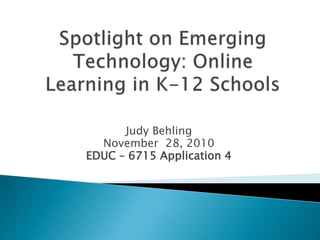
Spotlight on emerging technology
- 1. Judy Behling November 28, 2010 EDUC – 6715 Application 4
- 2. E-School provides an alternative to the traditional classroom environment. In an E-school, school takes place any time and virtually anywhere, as long as the student has access to a computer and the Internet. Allows for unique opportunities for 21st century students to use the skills they are so adept at.
- 3. Drop outs Home schooled students At risk students Home bound (sick, suspended, etc.) Gifted students (enrichment activities) Students with disabilities Students whose first language is not English Students in rural areas where access to resources is limited
- 4. “Moodle is a Course Management System (CMS), also known as a Learning Management System (LMS) or a Virtual Learning Environment (VLE). It is a Free web application that educators can use to create effective online learning sites” (http://moodle.org/)
- 5. Moodle is the abbreviation for Modular Object- Oriented Dynamic Learning Environment free and open-source e-learning software platform Focus on interaction and collaboration Moodle philosophy includes a constructivist/social constructionist approach to education
- 6. http://www.rcampus.com http://www.rcampus.com “RCampus is a comprehensive Education Management System and a collaborative learning environment... [with] innovative productivity tools [that]connect students and educators with important information crucial to student success while allowing school administrators real-time access to data for better tracking of institutional effectiveness. “ “Educators, students and school administrators can manage courses, build ePortfolios, create websites, join eCommunities, assess school work with rubrics and much more, from a single location. Everyone will find RCampus a familiar environment with tools that are easy and effortless to use.”
- 7. Free and open access ~ tools are openly and freely available for you to do your academic work. There's nothing to download or install. Quick and easy ~ quickly build courses and classes, websites, ePortfolios, rubrics, and much more. Highly secure ~ extra measures taken to provide a highly secure environment Collaborative ~ Students/faculty can collaborate in a number of ways, through communication tools within their courses, websites, communities, and ePortfolios, to collaboration on building and sharing content Lifelong ~ “Build for free - Keep forever” Comprehensive ~ Do all your work within a single login Cross-Campus ~ Build cross-campus clubs/groups, teach or learn at multiple schools using a single system, exchange books with students and find tutors at other campuses and schools around you. User-Centric ~ tools are truly user-centric - you are in control.
- 8. To fill the instructional gaps, educators must: “Become familiar with new technologies and knowledge resources, even those that at first blush do not seem at all related to their teaching. Incorporate new knowledge resources into the learning program of each student. Leverage these rich online tools to differentiate learning and engage reticent learners. Promote self-directed learning for all students. Seek out real-world applications of content and integrate those applications in student learning. Give students opportunities to communicate their understanding through a variety of media—print, video, Web 2.0, and more.” - Lemke & Coughlin, 2009
- 9. “The advent of low-cost global communications has led to mass collaboration in the social, economic, and political sectors. Young people are no exception; they expect to interact with and have a voice in everything they do—and that includes learning” (Lemke & Coughlin, 2009). “Today’s society is fraught with economic, environmental, social, and political challenges. Students are eager to learn in the context of these real world issues(Lemke & Coughlin, 2009).
- 10. PROS of E-LEARNING CONS of E-LEARNING Students can access work 24/7 Work can be completed online and corrected online (time and $ saving) Differentiated instruction using a variety of technology Allows for collaboration and/or discussion between class members and the instructor Allows for timely and relevant feedback Promotes self-directed learning Face to face interaction is all but eliminated access to computer and the Internet Technological abilities vary Students who procrastinate “Cheating”
- 11. Lemke, C., & Coughlin, E. (2009). The change agents. Educational Leadership, 67(1), 54–59. www.moodle.org/ www.rcampus.com